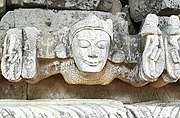Kamarupa Pithas
Kamarupa Pithas or Kamrup Piths are ancient pithas or geographical divisions of Kamarupa. The division of the Pithas are not consistent in different sources,[1] though the number of pithas are usually four. Since these pithas are not mentioned in the Kamarupa inscriptions, and are found mentioned only in later medieval texts some authors have suggested that these divisions are possible later fabrications.[2] The Yogini Tantra (16th- 17th-century), mentions the Kamarupa Pithas, the same work which gives boundaries of ancient Kamrup kingdom as well.[3]
| Part of a series on the |
| History of Assam |
|---|
 |
|
Proto-historic |
|
Late Medieval |
|
Modern |
|
Contemporary |
| Categories |
|
Part of a series on the |
|---|
| History of India |
Satavahana gateway at Sanchi, 1st century CE |
|
Ancient
|
|
Classical
|
|
|
|
Early modern
|
|
Modern
|
|
Related articles
|
Number of Pithas
The number of pithas reported are usually four, though some sources mention just three.[4]
The four Pithas were (i) Ratnapitha, the area from the river Karatoya to the river Sonkosh, (modern day Goalpara region), (ii) Kamapitha , from Sonakosh to the river Rupali (Kamrup region), (iii) Swarnapitha, from the river Rupali to the Bharali river (Central Assam) and (iv) Saumarapitha between the Bhairavi and the Dikarai river (Eastern Assam).[5][6]
According to the Kamrupar Buranji, the divisions are: (i) Ratnapith from the Maurang kingdom to Sankosh river; (ii) Kampith from Sankosh to Duimunisila; (iii) Bhadrapith from Kallang river to kailash river and (iv) Saumarpith from Duimunisila to Dikkaravasini.[7]
D C Sircar provides three different versions: (A) Kamapitha (Karatoya to Sankosh); Ratnapitha (Sankosh to Rupahi); Suvarnapitha (Rupahi to Bharali); and Saumarpitha (Bharali to Dibang near Sadiya). (B) Ratnapitha (Karatoya to Manas); Kamapitha (from Manas to Silghat on the northbank of Brahmaputra); Bhadrapitha (south bank, south of Kamapitha); and Saumarpitha to the east. (C) This boundary is taken from the haragaurisamvada: Ratnapitha (Karatoya to Sankosh); Kamapitha (Sankosh to Kapili); Suvarnapitha (Rupika to Bhairavi); and Saumarpitha (Bhairavi to Dibang).[8]
See also
- Kamrup
- Kamrupi
References
- "There are some conflicting accounts of the theoretical divisions of Assam" (Sircar 1990, p. 68)
- "These theoretical divisions are not known from the early epigraphic records and may have been fabricated in the late medieval period." (Sircar 1990, p. 68)
- Journal of the Assam Research Society - Volumes 13-15 - Page 90,1959 Yoginl-tantra divides Kamarupa into four pithas or region (Ratna pitha, Swarna pitha, Kama pitha, and Saumara pitha)
- "The Vrahadguvakastantra divides Kamarupa into three divisions-" (Shastri 1985, pp. 99–100)
- (Shastri 1985, p. 100)
- Kakati, Banikanta (1967). The mother goddess Kamakhya. p. 7.
- (Bhuyan 1930, p. 1)
- (Sircar 1990, p. 68)
Bibliography
- Gait, Edward A (1906), A History of Assam, Calcutta
- Bhuyan, S. K. (1930). Bhuyan, S. K. (ed.). Kamrupar Buranji (in Assamese). Assam: Department of Historical and Antiquarian Studies.
- Shastri, Biswanarayan (1985). "Tantra: A Neglected Source for Materials for History of Assam". Journal of the Assam Research Society. 28: 94–104.CS1 maint: ref=harv (link)
- Sircar, D C (1990), "Pragjyotisha-Kamarupa", in Barpujari, H K (ed.), The Comprehensive History of Assam, I, Guwahati: Publication Board, Assam, pp. 59–78CS1 maint: ref=harv (link)